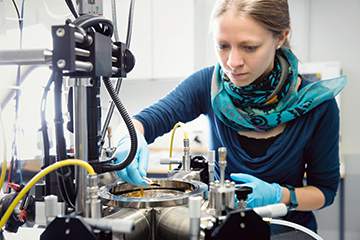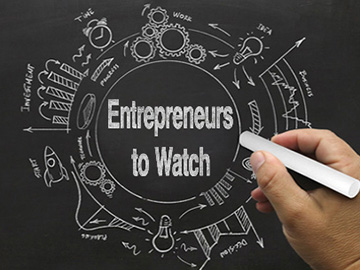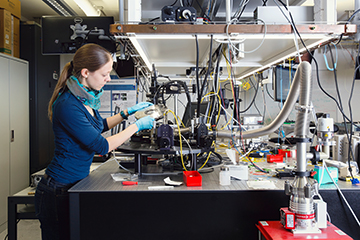
Claudia Hössbacher. [Image: Courtesy of Polariton]
The July/August 2023 issue of Optics & Photonics News featured the magazine’s biennial feature spotlighting 10 Entrepreneurs to Watch. Here, we offer an interview with one of those entrepreneurs, Claudia Hössbacher, the founder and CEO of Switzerland-based Polariton Technologies. Polariton's current focus is adding plasmonics to the integrated-photonics platform, and it sells what it says are “the world’s fastest and smallest electro-optic modulators” to help break the bottleneck between electrical circuits and optical fibers.
Could you briefly introduce Polariton Technologies?
Claudia Hössbacher: Polariton provides very small and fast photonic integrated circuits. The fastest and smallest in the market. Our customers are leaders in academia and industry. So we’re targeting the high-end, niche market. And our product is suitable for connectivity so that natural applications would be in optical communications. But of course, there are also other applications, such as sensing.
What’s the role of plasmonics in photonic integrated circuits, and why is this a particularly exciting area right now?
What’s exciting about this is the small size and high speed. So sizewise, if you look at active photonic devices, they are typically millimeters long. And if you add plasmonics to the photonic platform, you get down to micrometers. And that’s also important for speed … So with plasmonics, you can push the devices’ frequency response to the terahertz regime. And we can show a flat frequency response up to 500 gigahertz, which would not be possible with standard photonic modulators.

There is a need for data centers from optical communications to push toward higher data rates. And there are various ways to do that. Either you parallelize, push the speed of a single channel, or do both. And both are possible with plasmonics. Because they’re so small, you can highly parallelize them, and because they are so fast, you can push the speed of a single lane. So we can get to the terabits per second with that technology.
And you’re looking in particular at electro-optic modulators as a starting point.
Yes. It offers a conversion from electronics to optics. Basically, you have the servers that compute electrically, and then you have the fiber that transmits the data. In between, you need to convert from the electronic signal to the optical one. That’s a bottleneck at the moment, so that’s where we play a role.
Another way to see it is that electronics are super small. If you think of a transistor, around 5 nm nodes are used in CMOS. But photonic devices are still rather big, and that’s fundamentally because of the diffraction limit of light. With standard photonics, we can never reach the size of electronics. Plasmonics play an important role in bridging this gap. Basically, we’re playing with a metal-dielectric interface that you can put on any substrate. We mainly work with silicon photonics—SOI [silicon-on-insulator]—but in principle, you can also put it on glass, you can put it on top of a silicon germanium driver. So it’s pushing integration down closer to the level that’s possible with electronics through this plasmonic intermediary between light and electrons.
Could you talk a bit about when you first became interested in science and in optics and photonics in particular?
“With standard photonics, we can never reach the size of electronics. Plasmonics play an important role in bridging this gap.” —Claudia Hössbacher
I encountered optics and photonics during my bachelor’s study. I was studying electrical engineering at that time, and I came across the Light Technology Institute [at Karlsruhe Institute of Technology, Germany]. Then I started building lamps, and that was really fascinating. It was an inspiring environment.
So I decided to do a master’s degree in optics and photonics, which was very interdisciplinary. It was not just electrical engineering; it also involved physics and chemistry and mechanical engineering. I liked this interdisciplinary aspect of optics and photonics and I still do. The master’s degree program was also international. So it also opened my mind to other parts of the world, which was very important for me at that time. During the program, I had to do a lab course. And I decided to do something that I hadn’t ever done before.
That’s how I came across optical communications, which, before that date, I always thought was boring because it seemed it’s just about terabit per second and higher data rates. But then I discovered that, if you look closely into the system on the device level, many fascinating things are going on in the interactions between light and smaller structures. The light’s interaction with integrated circuits and being able to manipulate light on the smallest structures that you can’t see but can measure the results of—I still think that’s really fascinating.
“The light’s interaction with integrated circuits and being able to manipulate light on the smallest structures that you can’t see but can measure the results of—I still think that’s really fascinating.” —Claudia Hössbacher
I followed this interest in my Ph.D. For my master’s thesis, I still studied photonic integrated circuits. But then, the Ph.D. research offered me the opportunity to go to even smaller structures. That was quite compelling to me. I also liked that it was a very experimental work. Of course, the work also included theory, but experiments—something you can measure, something tangible—appealed to me.
Did your interest in science and engineering begin at an early age?
My mom likes to tell the story of how I liked to take apart a little optical instrument when I was in kindergarten. So I guess I’ve always tried to understand my surroundings and tried to experiment.
Is starting a business or being involved with one something that you’ve thought about for a while?
I haven’t planned this at all! It just happened to me.
When I started my Ph.D., I got started in a new group at ETH Zurich in Switzerland. And I like to tell this story—and this is really true—that, at that time, we didn’t even have a floor or a lamp. We really started from scratch. And very early, I got a lot of responsibility as a first-year Ph.D. student, including a lot of budget responsibility. And I enjoyed that, starting from scratch. Also, researchwise, plasmonics for communications was kind of new. Toward the end of my Ph.D., many others were also working in this field.
Then, I thought, we have good scientific results, good papers—but what’s next? I mean, research has to move forward. We’ve had a lot of interest from industry, people with big logos coming up to us and saying, “Okay, that’s interesting.” And we thought, “Well, if they are interested, we should try it. Go to the next step.”

You co-founded the company with two other people. How did that come together?
We were three colleagues in the same lab. Three friends said, “Okay, let’s take the next step.” We have slightly different backgrounds but relatively similar at the same time. For example, Benedikt [Bäuerle] was working on the systems side. I was working on the device side. And together, we benefited from each other. I had someone to help me test the devices, and he had someone to provide the newest generation of devices.
And then, of course, as the company grew, we needed many more skills and expertise. So step by step, we brought in other people with different backgrounds, which was very important because, otherwise, it’s not very diverse. I think it’s important to recruit from outside.
Perhaps we can talk a little bit more about that early history. Can you talk about how the company got off the ground?
We started by writing a business plan and going to startup competitions, which was very good because it forced us to write down our ideas, sharpening the plan. And each time we submitted a new proposal, it went through another iteration and it got better and better. And, of course, through that process, things changed. We didn’t do things exactly like we had planned at that time. But I would say it wasn’t a waste of time. It was good to do that.
“Each time we submitted a new proposal, it went through another iteration and it got better and better.” —Claudia Hössbacher
At a certain point, we had to stop going to startup competitions because it became more important to win customers. But, I think, for the starting phase—the first one to two years—getting access to an investor network is important. And there was a lot of support from various institutions. For example, I was awarded the ETH Pioneer Fellowship, which was very helpful because it came with networking opportunities with other founders.
And I’m still in contact with these people that I met at that time. We still exchange small questions like how do you run an AGM [annual general meeting]? Do you have a template for consultancy agreement? We also ask bigger things like, how do you decide on salaries? We don’t have to reinvent all these things. I think it’s important to have these exchanges with other founders. So in that way, the startup competitions helped us a lot.
Speaking of networks of investors, how did you go about attracting investor interest in the company?
I think the reason we were able to attract investors is because of a strong belief in the team. Before they supported us, the investors and our team had a long period of exchanges and many meetings.
They also liked the technology. The investors were also technology enthusiasts, and I think for a technology company, that was important. When we talked with other investors, we didn’t have this enthusiastic feedback. But the investors that we ended up with liked our product. It was a good match.
“I think the reason we were able to attract investors is because of a strong belief in the team.” —Claudia Hössbacher
What having investors changed for us in our daily operations was that we had to really set clear milestones and track them ourselves. Of course, you can say, “Well, you should always do that.” But honestly speaking, if there’s an investor, you raise the level of accountability.
Where have the company’s revenues come from thus far? It seems like Polariton offers some consulting in addition to products.
Yes, that’s correct. So the revenues come from product sales but also various services, including design services. We even did some packaging services, which is not our main business. But as a startup, you have to be opportunistic. This is also a foot-in-the-door kind of a thing. We provide a good quality service, and then we hope for a follow-up. So I think service is important in that respect, to get a foot in the door, to build trust and a long-term relationship.
In terms of product sales, the electro-optic modulator that we talked about earlier seems to be the only mature product now. Are there other devices or device components you’re looking to implement?
Right. The electro-optic modulator is really the main product. There are, of course, different versions of it. So there’s a phase modulator, a Mach-Zehnder modulator and a packaged version.
We believe that the electro-optic modulator is one of the key components at the moment. And since it’s integrated on PIC [photonic integrated circuit], on a standard SOI platform, it comes with all the other components around it. So we have gratings in the PDK [process design kit]. We have MMI [multi-mode interferometer], splitters, combiners and all these components that I used when working with silicon photonics.
“We believe that the electro-optic modulator is one of the key components at the moment.” —Claudia Hössbacher
We see the modulator as an MVP—a minimum viable product, to get started. The interest we see from the market is mostly in integrating systems on a chip. So it’s really then becoming a PIC, and the modulator becomes a critical component of the system.
I recently read about your joint efforts with Lightwave Logic. How do you view the role of partnerships and collaborations in achieving your vision for the company?
It’s super-critical. No one can do it alone. One of our company values is also teamwork. And this evolves internally: No one can do it alone. There is no single hero; we are all a team working together. But it applies to partners around the world as well. I think we should join efforts and see synergies rather than competing. One could see Lightwave as a competitor, but we can also see each other as partners and help each other succeed.
When you and the team get together and discuss what Polariton is doing, what kind of market opportunities do you talk about?
So I think with PICs in general, not just plasmonics, the main application is, of course, communications. And at the same time, there are many new applications coming up. This is thanks to new materials and new platforms that are being developed. And with those, we can address other needs like sensing. And with new wavelengths and new material platforms, the community together can seek new applications—some we might not even be aware of yet.
The PIC is not a product as such. It’s a platform for others to be creative—for example, in health care, with wearable technology. The AR/VR people are building optics into glasses. And in quantum, of course, there’s also a lot of optics involved, in things like optical interconnects between superconducting qubits and control electronics.

Claudia Hössbacher. [Image: Courtesy of Polariton]
If you were talking with somebody just getting started on an entrepreneurial project, what advice would you give?
The way I see it, no matter whether you work in science or in a startup, there is enormous uncertainty ahead. We haven’t been here before, and we don’t know what will happen. And the only way to handle this, for me, is to run experiments. We try something and we see what happens. We learn and do it again. And again and again.
When you look back on this, are there any specific milestones, events or moments that were particularly memorable?
I find it hard to name a specific moment. I mean, there are many firsts: the first sale, the first employee hired, the first investment. But I think what’s common to all of it is that things keep changing. This is a very exciting environment where we can learn together and also learn as individuals.
Where there anything surprising about starting and running a company, especially coming from academia?
What was surprising was how people see things differently. Academia is mainly in a research group, and a startup is a team. So academia is more focused on individuals, and a startup is more like we’re performing together. But of course, also in science, there are these big experiments where everyone needs to work together. But honestly speaking, I think it’s rare. I don’t want to speak badly about academia, but it is so different. Because in science, you have the first author, who’s kind of the “hero.” But in a startup, it is different—for me, at least.
Also, academia is more about the invention—creating an idea and coming up with something new. In a startup, it’s all about implementation. So it’s implementing an idea, following through and thinking about every detail. So it’s not just the “R” in R&D; it’s also development work. And that is very different. I hadn’t thought about it this way before I founded a company—what is development and what is research?
“Academia is more about the invention—creating an idea and coming up with something new. In a startup, it’s all about implementation.” —Claudia Hössbacher
You’re from Germany originally, but you moved to Switzerland. How do you like it there?
It’s a beautiful country. There are the mountains, the lakes and the old towns. We’re very lucky to have a company here. It also helps when trying to attract talent!

